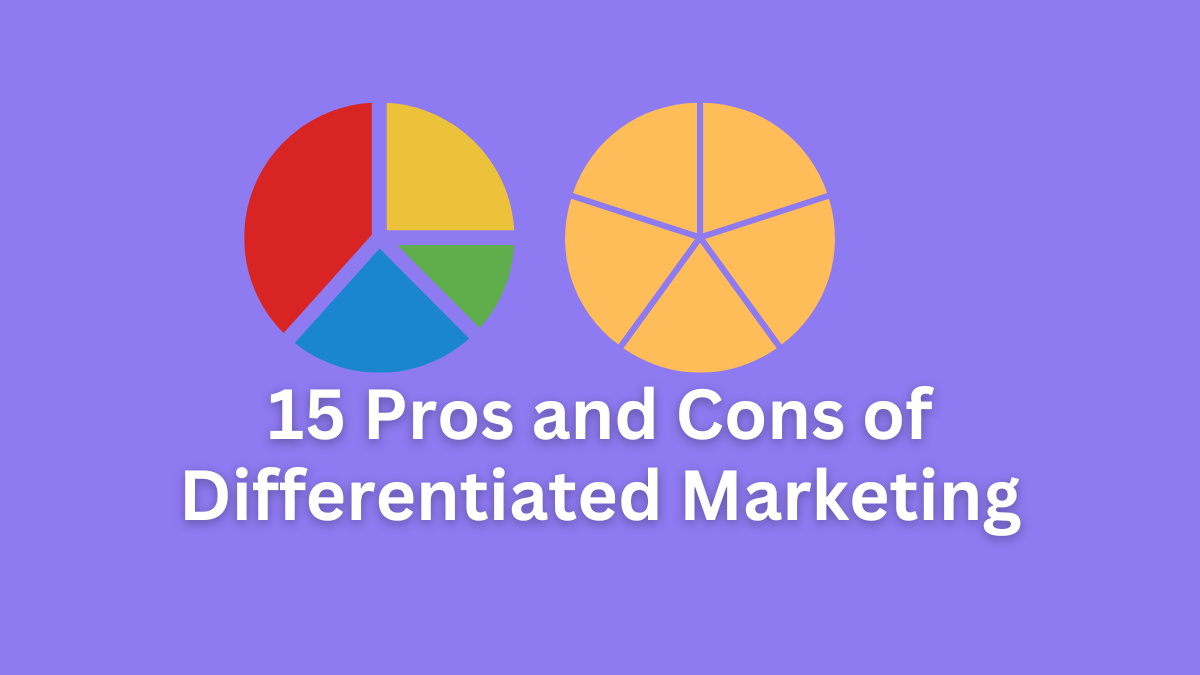Pros and Cons of Differentiated Marketing
Differentiated marketing refers to a marketing strategy where the company uses different marketing strategies for different consumer groups based on their preferences. Here we will explore some pros and cons of differentiated marketing, also called segment marketing. Let’s get started:
Pros of Differentiated Marketing
Differentiated marketing offers several advantages to businesses, making it a valuable marketing strategy. Here are eight pros of differentiated marketing to mention:
Expanded Customer Base
Differentiated marketing allows a business to reach a broader spectrum of consumers. By tailoring products and messages to various customer segments, you can attract a more diverse range of customers. This expansion can lead to increased sales and market share.
Customer Satisfaction
When you understand specific customer needs and preferences, you’re more likely to satisfy them. This can result in higher levels of customer satisfaction and loyalty. Customers appreciate when a business understands and addresses their unique requirements, leading to repeat purchases and positive word-of-mouth.
Read More: Mass Marketing – Definition
Competitive Advantage
In a competitive market, offering differentiated products and experiences sets your business apart. You can position your brand as unique and better suited to meet specific customer demands. This competitive advantage can help you stand out, even in crowded industries.
Effective Resource Allocation
Differentiated marketing encourages efficient resource allocation. Instead of spreading your marketing budget thinly across a broad audience, you focus on the segments that are most likely to respond positively. This targeted approach minimizes waste and maximizes the impact of your resources.
Brand Loyalty
When customers find a brand that consistently caters to their preferences, they tend to become loyal. This loyalty can translate into long-term relationships, higher customer lifetime value, and reduced customer churn.
Read More: 15 Examples of Mass Marketing
Higher Profit Margins
Differentiated products often command higher prices. Customers are willing to pay more for products that meet their specific needs or offer unique features. This can lead to improved profit margins compared to selling generic, undifferentiated products.
Adaptability to Market Changes
By catering to multiple segments, your business becomes more adaptable. If one market segment becomes less profitable or competitive, you can shift your focus to another. This flexibility allows you to respond effectively to changing market conditions and consumer preferences.
Stronger Brand Identity
Differentiated marketing reinforces your brand identity. When you consistently deliver tailored products and messages, you strengthen your brand’s image as an expert in serving specific customer needs. This clear identity helps consumers associate your brand with their desired solutions, enhancing brand recall and recognition.
Read More: 7 Steps in Market Segmentation Process
Cons of Differentiated Marketing
While differentiated marketing offers various advantages, it also comes with several disadvantages and challenges for businesses to consider. Here are seven cons of differentiated marketing, explained in detail:
Increased Costs
Implementing a differentiated marketing strategy can be costly. Developing unique products, tailored marketing campaigns, and targeted distribution channels for each segment requires additional resources. These costs can eat into a company’s profit margins.
Complexity in Execution
Managing multiple segments can be complex. It demands a deep understanding of each segment’s unique needs, preferences, and behaviors. Coordinating various marketing efforts and ensuring consistent messaging across segments can be challenging and time-consuming.
Read More: Market Segmentation – Definition, Types,
Risk of Cannibalization
Offering multiple variations of a product may lead to cannibalization, where one product within your portfolio competes with another. Customers from different segments might end up choosing the same product, leading to missed opportunities for differentiation and potential confusion.
Market Saturation
In highly competitive markets, differentiation may become difficult to sustain. Competitors can quickly mimic successful strategies, eroding your unique selling points. This can lead to price wars and reduced profitability.
Read More: Industrial Products
Resource Intensity
Successfully catering to multiple segments requires a substantial allocation of resources. Small businesses or startups with limited budgets may find it challenging to execute a differentiated marketing strategy effectively.
Inconsistent Brand Image
Managing multiple customer segments can sometimes result in an inconsistent brand image. If not executed meticulously, variations in messaging or product quality may confuse customers and dilute brand equity.
Market Fragmentation
As you divide your market into smaller segments, you risk creating market fragmentation. This means that you may capture a smaller share of each segment, potentially limiting your overall market share compared to a more concentrated approach.
Read Next: Fast Moving Consumer Goods (FMCG)
Arti Kushmi holds a BBS (Bachelor in Business Studies) degree and shares her business and marketing knowledge through this website. While not writing she will be reading and enjoying the moment.
